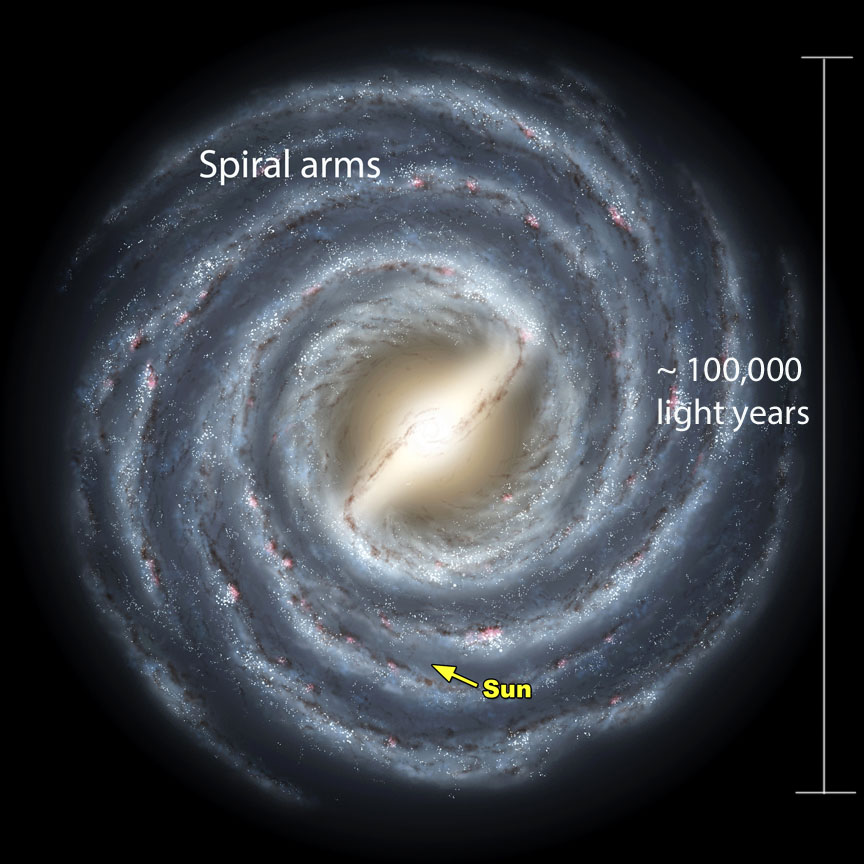
Two Million Stars on the Move
Gaze into Gaia's crystal ball and you will see the future. This video shows the motion of 2,057,050 stars in the coming 5 million years from the Tycho-Gaia Astrometric Solution sample, part of the first data release of European Space Agency's Gaia mission back in September 2016.
Gaia is a space observatory parked at the L2 Lagrange Point, a stable place in space a million miles behind Earth as viewed from the Sun. Its mission is astrometry: measuring the precise positions, distances and motion of 1 billion astronomical objects (primarily stars) to create a three-dimensional map of the Milky Way galaxy. Gaia's radial velocity measurements — the motion of stars toward or away from us — are providing astronomers with a stereoscopic and moving-parts picture of about 1% of the galaxy's stars.

Think about how slowly stars move from the human perspective. Generations of people have lived and died since the days of ancient Greece and yet the constellations outlines and naked eye stars appear nearly identical today as they did then. Only a few stars — Arcturus, Sirius, Aldebaran — have moved enough for a sharp-eyed observer of yore to perceive their motion.

Given enough time, stars do change position, distorting the outlines of the their constellations. This view shows the sky looking north in 91,000 A.D. Both Lyra and the Big Dipper are clearly bent out of shape! Created with Stellarium
We know that stars are constantly on the move around the galactic center. The Sun and stars in its vicinity orbit the core at some half-million miles an hour, but nearly all are so far away that their apparent motion has barely moved the needle over the time span of civilization as we know it.
This video shows more than 2 million stars from the TGAS sample, with the addition of 24,320 bright stars from the Hipparcos Catalogue that are not included in Gaia's first data release. The video starts from the positions of stars as measured by Gaia between 2014 and 2015, and shows how these positions are expected to evolve in the future, based on the stars' proper motions or direction of travel across space.

This frame will help you get your footing as you watch the video. Orion (at right) and the Alpha Persei stellar association and Pleiades (at left) are shown. Credit: ESA/Gaia/DPAC
Watching the show
The frames in the video are separated by 750 years, and the overall sequence covers 5 million years. The dark stripes visible in the early frames reflect the way Gaia scans the sky (in strips) and the early, less complete database. The artifacts are gradually washed out as stars move across the sky.
Using the map above to get oriented, it's fun to watch Orion change across the millennia. Betelgeuse departs the constellation heading north fairly quickly, but Orion's Belt hangs in there for nearly 2 million years even if it soon develops sag! The Pleiades drift together to the left and off frame and then reappear at right.
Stars seem to move with a wide range of velocities in the video, with stars in the galactic plane moving quite slow and faster ones speeding across the view. This is a perspective effect: most of the stars we see in the plane are much farther from us, and thus seem to be moving slower than the nearby stars, which are visible across the entire sky.

Artist's impression of The Milky Way Galaxy to provide context for the video. The Sun and solar system are located in the flat plane of the galaxy, so when we look into the Milky Way (either toward the center or toward the edge), the stars pile up across the light years to form a band in the sky. If we could rise above the disk and see the galaxy from the halo, we'd be able to look down (or up) and see the galaxy as a disk with winding spiral arms. Credit: NASA
Some of the stars that appear to zip in and out of view quickly are passing close to the Sun. But motion of those that trace arcs from one side of the sky to the other while passing close to the galactic poles (top and bottom of the frame) as they speed up and slow down, is spurious. These stars move with a constant velocity through space.
Stars located in the Milky Way's halo, a roughly spherical structure centered on the galaxy's spiral disk, also appear to move quite fast because they slice through the galactic plane with respect to the Sun. In reality, halo stars move very slowly with respect to the center of the galaxy.
The visualization early shows some of the interstellar gas and dust clouds that occupy vast spaces with the galaxy and block the view of more distant suns. That these dark clouds seem to disappear over time is also a spurious effect.
After a few million years, the plane of the Milky Way appears to have shifted towards the right as a consequence of the motion of the Sun with respect to that of nearby stars in the Milky Way. Regions that are depleted of stars in the video will not appear that way to future stargazers but will instead be replenished by stars not currently sampled by Gaia.
I find the video as mesmerizing as watching fireflies on a June night. The stars seem alive. Enjoy the journey!